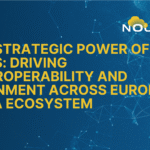Authors: Tina Črnigoj Marc, Tomislav Šubić, Arctur
The European Union (EU) is a global leader in driving digital innovation, championing initiatives that incorporate high-performance computing (HPC), quantum technologies, data sovereignty, and edge computing. These cutting-edge advancements are supported by robust policies and partnerships designed to enhance Europe’s digital independence and global competitiveness.
Europe’s digital transformation aims to be inclusive, prioritizing people’s needs while creating new opportunities for businesses. Data is a critical asset, powering economic growth, fostering innovation, and enabling job creation. Its transformative potential extends to society at large, offering breakthroughs in personalized medicine, advancing sustainable mobility solutions, and supporting the goals of the European Green Deal [1].
The vast proliferation of data is reshaping industries, public institutions, and consumer interactions. Recognizing this, the EU launched the European Strategy for Data in 2020, laying the groundwork for a data-driven future [2]. A cornerstone of this strategy is the establishment of shared European data spaces across key sectors and areas of public interest.
These data spaces represent a pivotal step toward a collaborative data ecosystem in Europe. Drawing on the success of the European Open Science Cloud, the EU is working to create nine additional sector-specific data spaces [3], [4]. Furthermore, the EU’s vision encourages the emergence of new data spaces in fields such as cultural heritage, smart cities, language, media, and tourism, supported by preparatory actions to ensure their development and integration.
Through these initiatives, the EU is positioning itself as a trailblazer in leveraging data to foster innovation, drive economic growth, and deliver meaningful societal benefits.

Figure 1: Common European Data Spaces [4]
Europe’s AI Factories initiative is designed to accelerate the advancement and adoption of artificial intelligence (AI) technologies across the European Union. Rooted in the EU’s Digital Strategy, these factories align with the vision of creating common European Data Spaces, promoting AI innovation while upholding core European values such as transparency, fairness, and sustainability. The initiative aims to strengthen Europe’s global AI competitiveness while fostering trust in AI systems.
In January 2024, a set of measures was introduced to assist European startups and SMEs in developing trustworthy artificial intelligence (AI) that aligns with EU values and regulations. This initiative complements the AI Act, which aims to foster the development, deployment, and adoption of reliable AI within the EU. The package is tailored to support AI-driven startups and innovation, including a proposed amendment to the EuroHPC Regulation that would facilitate the creation of AI factories. The EuroHPC infrastructure will play a crucial role in supporting this initiative [5].
These AI Factories serve as collaborative hubs where researchers and industry stakeholders can develop, test, and refine AI models. By leveraging high-quality, domain-specific datasets from the EU’s Data Spaces, the factories support the training of AI algorithms in compliance with European data protection regulations, such as GDPR. They also encourage cross-sectoral innovations, enabling synergies—for example, combining mobility and healthcare data to create advanced emergency response systems.
AI Factories are poised to transform various sectors, including healthcare, manufacturing, energy, and public services. They enable cutting-edge applications such as digital twins, predictive analytics, and AI-driven automation. Public-sector benefits include the development of AI tools for disaster management, personalized education, and other civic applications [6].
This initiative underscores Europe’s commitment to ensuring AI-driven progress aligns with ethical and sustainable principles while contributing to the region’s digital transformation.
Development of HPC Infrastructure
Through the EuroHPC Joint Undertaking (JU), the European Commission, Member States, and Associated Countries will collectively invest €2.1 billion to acquire new EuroHPC supercomputers, upgrade existing systems with advanced AI capabilities, and establish supercomputing services tailored for AI applications. This investment will also support the development of AI-focused microprocessors and initiatives to enhance relevant skills [6].
The development of HPC and cloud infrastructure directly supports the European Union’s data spaces initiative and innovation goals by providing the necessary computational power, storage, and integration capabilities. These infrastructures enable the collection, processing, analysis, and sharing of vast datasets across multiple domains, fostering interoperability and driving breakthroughs in research, industry, and public services. Below are the ways in which HPC and cloud development align with data spaces and innovation.
European HPC and cloud initiatives, such as Gaia-X and EuroHPC JU, prioritize data sovereignty by ensuring that data storage, processing, and governance adhere to EU regulations. These frameworks provide secure environments for innovation while maintaining compliance and protecting sensitive information. The Gaia-X European Association for Data and Cloud represents the core of the organisational structure. It is an international non-profit association under Belgian law. It was founded to develop the technical framework and operate the Gaia-X Federation services, linking many cloud service providers and users together in a transparent environment that will drive the European data economy of tomorrow [7].
Since its creation in 2018, the EUROHPC JU has substantially increased overall investments in HPC at the European level and has started to restore Europe’s position as a leading HPC power globally. The Joint Undertaking is not only procuring supercomputers but investing in research to develop innovative and competitive supercomputing technologies, applications, skills and expertise, based on a supply chain that is reducing Europe’s dependency on foreign suppliers. EuroHPC JU is responsible for establishing a network of nine state-of-the-art supercomputers across Europe [8]. To date, LUMI and Leonardo are among the top 10 global HPC systems according to the TOP500 list [9]. Jupiter, the first European exascale system is being built in the Forschungszentrum Julich campus in Germany. These systems are among the most powerful globally and serve critical roles in scientific research, industrial innovation, and public services. EuroHPC JU funds and coordinates research projects to develop cutting-edge HPC applications, software, technologies, hardware and skills. This fosters innovation in areas such as artificial intelligence, precision medicine, and advanced materials design.
Additionally, EUROHPC JU is developing innovative, home-grown and sustainable HPC technologies.
The EPI SGA2 initiative focuses on developing a roadmap for a new generation of energy-efficient European processors tailored for extreme-scale computing, high-performance Big Data processing, and emerging applications [10]. Complementing this, the EUPEX pilot unites academic and commercial stakeholders to co-design a modular, Exascale-ready system [11]. Together, these projects will establish a comprehensive hardware and software platform that integrates European technologies, demonstrating their scalability and readiness for Exascale computing, with a particular emphasis on the Modular Supercomputing Architecture (MSA) [12].
Additionally, the European PILOT initiative aims to create the first fully European, open-source, and open-standard integrated HPC system. This project will develop an autonomous suite of accelerators designed, manufactured, and deployed entirely within Europe [13].
Edge Computing and IoT
Edge computing and the Internet of Things (IoT) are pivotal to Europe’s digital transformation, driving the development of interconnected and interoperable systems that reflect fundamental EU values. Positioned at the heart of the global digital economy, edge computing operates through a multi-layered technological framework, enabling the management and automation of connected IoT devices. Advancing the next generation of IoT will require robust edge computing capabilities to support Europe’s digital sovereignty and ensure the resilience of future ICT systems [14].
The EU implements rigorous security standards for IoT devices and edge computing systems through initiatives such as the Cybersecurity Act (2019). This legislation introduced an EU-wide cybersecurity certification framework for connected devices, including IoT hardware, software, products, and services. Businesses operating within the EU benefit from a streamlined process, needing to certify their ICT products, processes, and services only once, with certificates recognized across all Member States [15].
Another directive that provides measures for a high common level of cybersecurity across the Union is the NIS2 Directive. It Strengthens the security of critical infrastructure, requiring IoT providers and edge computing services to adopt robust measures against cyber threats [16].
NOUS project: Empowering Europe’s Data Future
The NOUS project is a trailblazing initiative focused on envisioning, designing, and deploying advanced cloud services tailored for the era of data spaces, high-performance computing, and edge computing. Committed to driving innovation, NOUS is shaping the future of technology by leveraging the potential of cloud solutions and redefining the limits of what can be achieved in the digital age [17].
The NOUS project recognizes the need to develop state-of-the-art cloud technologies and make them widely accessible. Its focus lies in enabling efficient data sharing, exchange, and the creation of trustworthy data infrastructures. Inspired by the vision of providing advanced technological services, NOUS aims to support scientists and professionals running complex, compute-intensive algorithms on a commercial cloud platform.
This initiative seeks to enhance Europe’s position in the global cloud market, where non-European providers currently hold a 75% share. Rather than restricting the use of foreign technologies, as some European strategies propose, NOUS introduces a forward-thinking approach to cloud infrastructure. It prioritizes scientific excellence and fosters the growth of high-performance digital services within the European economy [18].
The NOUS project includes a set of use cases that present specific challenges. These challenges will be addressed by NOUS through the development of new technologies within an industrially relevant environment. The use cases will address:
- Automotive sector, improving the perception of connected vehicles by using roadside and car cameras;
- Energy sector, managing the lifecycle of energy data and energy prediction for optimisation of selling prices in the electricity markets;
- Crisis management; for improving data lifecycle management;
- Science: managing and analysing complex datasets from various scientific fields.
Future Outlook
The growing adoption of cloud HPC could benefit European customers by providing cost-effective access to HPC resources, particularly for small and medium enterprises that cannot afford dedicated HPC infrastructure. However, reliance on global cloud providers may raise concerns about data sovereignty and compliance with stringent EU data protection laws. Hybrid models, combining on-premises and cloud resources, are likely to gain traction as they address these concerns while offering flexibility and scalability.
With initiatives like the Horizon Europe program driving research and innovation and execution of programmes and activities through the EUROHPC JU, Europe is well-positioned to lead in areas like sustainable digital transformation, AI ethics, and green technologies. By fostering international partnerships while championing its values, the EU is crafting a digital future that balances innovation, privacy, and inclusivity. NOUS will contribute to the strategies by exploiting connections with Data Spaces to foster data sharing and provide data analytics-related services, especially focusing on knowledge sharing and collaboration.
References
|
[1] |
“European Commission,” 2024. [Online]. Available: https://single-market-economy.ec.europa.eu/industry/strategy/digital-transformation_en. |
|
[2] |
“European Commision,” [Online]. Available: https://digital-strategy.ec.europa.eu/en/policies/strategy-data. [Accessed 2024]. |
|
[3] |
“European Commission,” 2024. [Online]. Available: https://research-and-innovation.ec.europa.eu/strategy/strategy-research-and-innovation/our-digital-future/open-science/european-open-science-cloud-eosc_en. |
|
[4] |
“Common European Data Spaces,” 2024. [Online]. Available: https://dataspaces.info/common-european-data-spaces/#page-content. |
|
[5] |
“European Commission,” 2024. [Online]. Available: https://digital-strategy.ec.europa.eu/en/policies/regulatory-framework-ai. |
|
[6] |
“European Commission,” 2024. [Online]. Available: https://digital-strategy.ec.europa.eu/en/policies/regulatory-framework-ai. |
|
[7] |
“GaiaX,” 2024. [Online]. Available: https://gaia-x.eu/. |
|
[8] |
“EUROHPC JU,” 2024. [Online]. Available: https://eurohpc-ju.europa.eu/index_en. |
|
[9] |
“Top500,” 2024. [Online]. Available: https://top500.org/lists/top500/. |
|
[10] |
“EPI,” 2024. [Online]. Available: https://www.european-processor-initiative.eu/dissemination-material/epi-sga2-building-europes-high-performance-computing-capabilities/. |
|
[11] |
“EUPEX,” 2024. [Online]. Available: https://eupex.eu/. |
|
[12] |
“Deep Prjects,” 2024. [Online]. Available: https://deep-projects.eu/modular-supercomputing/. |
|
[13] |
“EUPILOT.EU,” 2024. [Online]. Available: https://eupilot.eu/. |
|
[14] |
“European Commission,” 2024. [Online]. Available: https://digital-strategy.ec.europa.eu/en/policies/next-generation-internet-things. |
|
[15] |
“European Commission,” 2024. [Online]. Available: https://digital-strategy.ec.europa.eu/en/policies/cybersecurity-act. |
|
[16] |
“European Commission,” 2024. [Online]. Available: https://digital-strategy.ec.europa.eu/en/policies/nis2-directive. |
|
[17] |
“NOUS Project,” 2024. [Online]. Available: https://nous-project.eu/. |
|
[18] |
“ACM Digital Library,” 22 October 2024. [Online]. Available: https://dl.acm.org/doi/10.1145/3685651.3686660. [Accessed 2024]. |
|
[19] |
“European Commission,” [Online]. Available: https://digital-strategy.ec.europa.eu/en/policies/ai-factories. |





